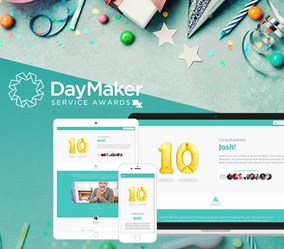Each new year brings an opportunity to improve and advance your organization. Use the five trends below to create a comprehensive strategy for the year ahead to increase employee engagement, develop exceptional leadership and drive great business results.
TREND #1: Bring your employee value proposition to life.
Why should prospective employees choose to work for you over someone else? Why do your current employees choose to stay? Focus on what current, future and even former employees love about your brand to create a unique employee value proposition that will attract, engage and retain the best people. But don’t stop there. Your EVP is just words until it’s brought to life through every aspect of your business, from onboarding and training to recognition and rewards through employee surveys and program measurement. A successful EVP campaign will rally employees around what your brand stands for and help them love where they work.
TREND #2: Empower new employees.
In today’s workforce, companies can’t expect new hires to come on board and stay their entire career. Propelled by a recovering economy, shortage of “knowledge” talent and sophisticated, aggressive online recruiting, as many as one-third of new employees are already job searching within six months of being hired. That’s an HR nightmare. The solution? Be strategic about your onboarding approach, from the time a person is hired through their first year of employment and beyond. New employees are more likely to stay if they:
- catch on to the culture quickly,
- acquire a network of people who can help them be successful
- feel supported in their career, in both current and future roles, and
- understand how their work fits into the company's overall strategy and objectives.
These four factors also impact what’s called “time to performance”, or how long it takes before a new employee is up to speed and productive. Both unnecessary turnover and time to performance can be addressed with a thoughtful, well-executed onboarding program.
TREND #3: Turn recognition into results.
Recognition and reward programs have a long history of successfully improving engagement, retention and productivity. But lately companies are starting to look beyond “traditional” uses and instead are leveraging recognition programs to drive their strategic and financial goals. Results-based recognition is a methodology that aligns both sales and non-sales employee efforts towards organizational initiatives. Both teams and individuals are given specific measurable goals and earn rewards once they’ve accomplished them. By designing results-based recognition programs using behavioral economics, each employee feels like the goal they’re working toward is achievable and has a clear view of how their work fits into the bigger picture. Combining recognition, rewards and maximum engagement creates a strong, dynamic program that delivers incremental business results.
TREND #4: Recognize good managers.
Managers have a tremendous impact on their employees’ wellbeing, both at work and in their personal lives. However, the majority of managers are not creating environments in which employees feel comfortable or motivated to do their jobs, let alone do them well. In fact, at some point in their career, one in every two people has left a job to escape a bad manager (Adkins & Harter, HBR, 2015). And when it comes to engagement, what goes around comes around; in fact, managers account for up to 70% of variance in employee engagement scores (Adkins & Harter, HBR, 2015). So why aren’t more managers held accountable for their performance (or lack thereof)?
The bottom line is this: Happy managers foster happy employees, leading to great performance and great results. Maximize your managers’ engagement by measuring, recognizing and rewarding them for desired behaviors and performance.
TREND #5: Invest in leadership development.
More and more, companies are realizing their leaders are not only responsible for defining and executing company strategies but also for impacting employee performance. Developing the right leaders, who do the right things, has a positive impact on employees’ engagement, job satisfaction, discretionary effort, well-being, innovation, creativity and intent to leave the company. These compassionate leaders, known for exhibiting behaviors like dignity, authenticity, accountability, empathy and integrity, create environments in which employees feel comfortable and motivated, leading to higher performance and greater business results. The most effective leadership development programs create, develop and promote compassionate leaders through training and recognition.
To learn more about how BI WORLDWIDE can deliver an inspiring global engagement and recognition strategy for your organization, email info@biworldwide.com.
The best way to get started is to get in touch















